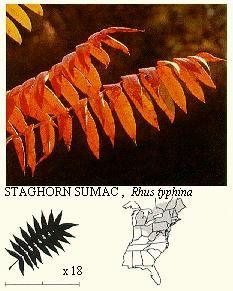 back to Visual
Reference Guide Staghorn Sumac The large dark crimson - or rarely orange to yellow - pinnate leaves of this sumac have 15-31 narrow, ellipti to lanceolate, serrate leaflets that can be up to 15 cm (6") long. The stems and fruits of Staghorn Sumac are densely hairy, as in the "velvet stage" of a stag's antlers. These colorful, nonpoisonous shrubs or small trees are rhizomatous. The large clumps form bright splashes of color along forest margins, road banks, and fencerows and in old fields over much of the Appalachians. Staghorn Sumac is rare or absent at lower elevations in the south. Smooth Sumac (Rhus glabra) is a similar and more common Sumac often seen along highways. Poison Sumac (Rhus vernix) is a toxic cousin which usually grows in swamps, bogs, and low moist areas, often in the shade of taller trees. It is not as common as Poison Ivy, but the oil is stronger and produces a more painful irritation.
compiled from "Fall Colors & Woodland Harvests" & "Fall Color Finder" by Laurel Hill Press |



